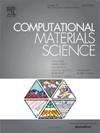Accurate prediction of structural and mechanical properties on amorphous materials enabled through machine-learning potentials: A case study of silicon nitride
IF 3.1
3区 材料科学
Q2 MATERIALS SCIENCE, MULTIDISCIPLINARY
引用次数: 0
Abstract
Ab initio calculations represent the technique of election to study material system, however, they present severe limitations in terms of the size of the system that can be simulated. Often, the results in the simulation of amorphous materials depend dramatically on the size of the system. Here, we overcome this limitation for the specific case of mechanical properties of amorphous silicon nitride (a-SiN) by training a machine learning (ML) interatomic model. Our strategy is based on the generation of targeted training sets, which also include deliberately stressed structures. Using this dataset, we trained a moment tensor potential (MTP) for a-SiN. We show that molecular dynamics simulations using the ML model on much larger systems yield elastically isotropic response and can reproduce experimental measurement. To do so, models containing at least atoms are necessary. The Young’s modulus calculated from the MTP at room temperature is 220, which is very well in agreement with the nanoindentation measurement. Our study demonstrates the broader impact of machine learning potentials for predicting structural and mechanical properties, even for complex amorphous structures.

求助全文
约1分钟内获得全文
求助全文
来源期刊

Computational Materials Science
工程技术-材料科学:综合
CiteScore
6.50
自引率
6.10%
发文量
665
审稿时长
26 days
期刊介绍:
The goal of Computational Materials Science is to report on results that provide new or unique insights into, or significantly expand our understanding of, the properties of materials or phenomena associated with their design, synthesis, processing, characterization, and utilization. To be relevant to the journal, the results should be applied or applicable to specific material systems that are discussed within the submission.
 求助内容:
求助内容: 应助结果提醒方式:
应助结果提醒方式:


